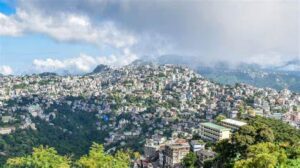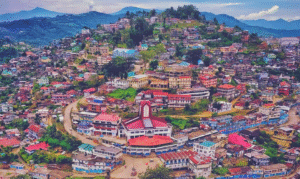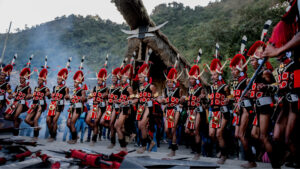Haflong is a multi-ethnic, multi-linguistic-only hill town amongst the terrain of Assam. This unique geographical elevation in Dima Hasao paints a picturesque backdrop. Surrounded by lush greenery, waterfalls, and rolling hills, Haflong sits at an elevation of 1,683 feet above sea level. The town is surrounded by breathtaking views and climate.
Flowing through the landscape are meandering streams, adding a soothing touch to the surroundings. Haflong’s geography is defined by its hilly terrain, creating a cozy and tranquil atmosphere. The town’s elevation not only provides a cool climate but also contributes to its distinct charm.
Beaming with diverse flora and fauna enhancing the natural beauty, Haflong’s geography is home to the tribals of the North Cachar Hills.
History
Haflong is the capital of the North Cachar Hills. Before India’s independence from the British colonizers, it belonged to the Dimacha Kingdom. Later, it was integrated with Assam. The name Haflong itself is derived from the Dimasa word ‘Hafloong’, which means ant hill. However, the original story of how the name came to be is still contested.
Culture
In this cozy town of Assam, friendly faces from diverse backgrounds make up the population. Haflong’s diversity extends to more than 12 ethnic tribes, each contributing to the vibrant mosaic of the town. Dimasa, Zeme Naga, and Hmar are the major tribes. An interesting fact about Haflong is that there are more percentage of females than males making up the population.
Traditional Practices
All around the year, colorful festivities bring the town to life. Whether it’s Bihu, where everyone dances to traditional tunes, or other tribal festivals like Wangala or Domashi, the air is filled with joy and vibrant traditions.
In Haflong, the main celebration is Bushu, a festival that connects to their love for farming. Each tribe has unique ways to celebrate, passed down through generations. Over time, some of these rituals merged with Hindu traditions, creating a fascinating cultural blend. These festivals bring people together, both within their communities and with others in the area.
There’s no shortage of music and dance in Haflong thanks to its many tribes! Most are traditional forms, each with its style and story. Some famous dances include Haripivelim, Johumpeselim, and Kanguibelim. They use special costumes and music, often telling stories about their history and beliefs.
It reflects the diverse religious and cultural fabric of the community. These festivals bring people together, fostering unity and harmony in Haflong.
Language
Hindi, English, Urdu, Bengali, Assamese, and various tribal dialects are the officially spoken languages in Haflong. However, the locals have come up with a pidgin language to communicate with others and themselves.
It has become the most common language, something that has grown to be a part of their culture and is inseparable now. It eases the everyday conversational transactions that one needs to do with traders, employees, and officials.
Culinary Delights
Food is a big part of Haflong’s culture. Every day is a celebration, and the town’s heart beats with the rhythm of unity in diversity. Traditional dishes like fermented fish and smoked meat reflect the rich heritage, while the younger generation explores new tastes, embracing Sino-Indian and international flavors.
The jar of judima is the traditional rice wine of the Dimasas. Sipped from a copper bowl, this indigenous delight evolves in flavor over time, much like a fine tea. Dimasa culinary traditions, emphasize fermented fish, smoked meat, and khari dishes. The market also features unique offerings such as silkworm chutney and the delicacy of weaver ants, considered both a culinary delight and traditional medicine.
Haflong offers a diverse range of cuisines, influenced by the cultural amalgamation in the region. Assamese cuisine dominates, featuring dishes like Assam Laksa, Khar, and various rice-based preparations. Local tribal cuisines, such as Dimasa and Hmar, contribute unique flavors with dishes like Bamboo Shoot Pork and Bamboo Shoot Chicken.
Moreover, you can savor traditional Assamese sweets like Pitha during festivals. Tea, given Assam’s prominence in tea production, is a staple beverage. Street food options also thrive, offering a mix of flavors that cater to different tastes in Haflong.
Halong’s market is celebrated with community bonding. People cherish their local produce – from seasonal vegetables to the special Judima rice wine. It’s a place where stories are shared, and diversity becomes a source of pride.
Nature’s treat
Haflong is covered with enchanting waterfalls that enhance its scenic landscape, captivating both residents and visitors alike. The cascading waterfalls, such as Hatisor and Jatinga, add a touch of natural splendor to the town’s surroundings. These pristine falls, nestled amidst the hills, contribute to Haflong’s serene ambiance, making them popular spots for leisure and relaxation.
Fed by the abundant rainfall in the region, the waterfalls become a testament to Assam’s lush beauty, attracting nature enthusiasts seeking respite in the soothing sounds and breathtaking visuals of these picturesque water wonders. Haflong’s waterfalls stand as nature’s masterpiece, enhancing the town’s allure.
Occupation
The people of Haflong engage in diverse occupations that reflect the town’s cultural richness. Agriculture is prominent, with many cultivating seasonal crops like vegetables, lentils, and bamboo shoots.
Traditional practices such as weaving and crafting are integral, showcasing the skilled craftsmanship of the locals.
Small businesses, including local eateries and cafes, contribute to the evolving economy, offering a mix of traditional and international cuisines.
Additionally, there is a growing interest in tourism-related activities, with locals sharing their cultural heritage through guided tours and cultural experiences. This diverse spectrum of occupations encapsulates Haflong’s vibrant and evolving economic landscape.
Self Reliance
Locals unveil the significance of seasonal produce like vegetables, lentils, mushrooms, edible ferns (dhekia), bamboo shoots, and ginger in the traditional cuisines of Haflong’s diverse communities. In every borough of the town, there is a sense of community that keeps them together.
Conclusion
The town’s growing cosmopolitan nature is evident in the emergence of Sino-Indian food and the adoption of international flavors like Korean corn dogs inspired by the K-Pop culture. However, locals still seek to maintain its multicultural harmony by allowing themselves a big appetite and a lively zeal for life.
Haflong’s landscape mirrors its cultural diversity, where traditional practices intertwine with the population influencing and creating a unique and evolving experience.
Unravelling a billion untold stories, one chapter at a time, Humans of Northeast takes you on a discovery through vibrant Northeast India – a land rich in people, places, and culture. Ready to immerse yourself in more such stories? Visit our page HONEI to read more about narratives that inspire and uplift.






